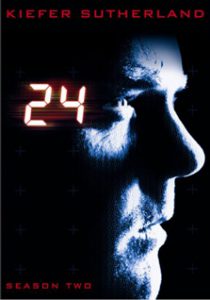Now would be a good time to rewatch “24” Season 2 (2002-03, Fox; now streaming on Amazon Prime). Centered on a terrorist nuclear bomb in Los Angeles and the buildup to war in the aftermath of its explosion (in the unpopulated desert, thanks to Jack Bauer, natch), this season is obviously a commentary on the U.S. invasion of Iraq, which began in March 2003, coinciding with the intense push-for-war episodes.
Still, Season 2 plays even better today because – while there are parallels to President Trump’s military response to the Syria chemical weapon attacks — it illustrates how so many taken-for-granted elements of the system of checks and balances are now anachronistic. It feels like a very 2003 thing that so much story time is devoted to Jack (Kiefer Sutherland) tracking down proof of the fake recordings that are the U.S. government’s pretense for war against three Middle Eastern countries. As much as Vice President Prescott (Jim Dale) and his fellow warmongers try to ignore the possibility that Bauer is onto something, there’s a sense in the narrative that these faked recordings matter.
Of course, “24” showrunners Robert Cochran and Joel Surnow are commenting on the weapons of mass destruction that were President Bush’s pretense, and — although the invasion and regime change went forward — public discussion of whether or not the WMDs existed was a mainstream talking point for a long time. Today, while there is some discussion about whether or not the Syrian government is responsible for the chemical attacks, there is more of a sense of resignation among the public about U.S. war policy.
Indeed, while the events of this single day happen too fast for the president to go to Congress and ask for a declaration of war, President Palmer (Dennis Haysbert) does say he intends to do that. In the real world, the 2003 Iraq war was the last war approved by Congress; after that, Presidents Bush and Obama argued that the 2001 Authorization for the Use of Military Force covered their actions. Even when Obama went to Congress in 2012 regarding Syria, he maintained that it was not a legal requirement. Many law experts believe Trump’s bombing of Syria is not covered by the AUMF. However, since Congress is unwilling to sue over its war-making powers being usurped, there will be no legal repercussions for the executive office.
In another throwback, Palmer is concerned about posse comitatus, which holds that the military may not be used against the American population – in this case, to quell rioting in Georgia after the nuclear explosion. While this law hasn’t been bent to the degree that war-making law has been, we’ve seen non-military organizations increasingly resemble the military in the past 14 years in response to terrorism; for example, the scenes during the wake of the 2013 Boston Marathon bombing.
With its fictional presidential administrations and increasingly sci-fi technology, “24” has always been set in an alternate reality. However, Season 2 particularly serves as a “What If” story where the U.S. has an anti-war president, something that an increasingly large percentage of the population has never experienced in their lifetime. President Palmer delivers the stirring, overarching message in the finale: “Leaders are required to have patience beyond human limits. The kind of action we nearly took should only be exercised after all other avenues have been exhausted. After the strictest standard of proof has been met.”

OK, enough with the themes. Season 2 also works as a masterful piece of action-TV art. I expected the believability of the real-time element to be thrown out the window, but it still mostly holds up. One glaring exception is when Jack calls U.S. agents in the Middle East; they are threatening terror suspect Syed Ali’s (Francesco Quinn) family as Jack tries to extract information, and there is no time delay whatsoever. We’ve all seen the awkward delay of a few seconds when news anchors talk to reporters on the other side of the globe.
I also thought Jack undergoing impromptu torture in the basement of an urgent care center pushed believability. And in the climactic showdown, it’s bizarre that villain Peter Kingsley (“Saw’s” Tobin Bell) lets Jack click his empty gun at him without flinching; how did he know it was spent?
Other than that, Season 2 is pure gold, driven by a decent plot and a bevy of wonderful pulp characters. Jack is in fine form, this time without much support from the Ryan Chappelle (Paul Schulze)-led CTU. Season 2 marks the debut of “outright badass” Jack. He awakes at 8 a.m. not even an official member of the CTU staff anymore, but by 9:12 he has cut off the head of a bad guy and delivered it to other bad-guy contacts as part of an undercover scheme. Later, he shoots a dog that’s attacking him. (The dog’s death happens offscreen, a courtesy not given to the many humans who bite the dust.) And he rips a cyanide-capsule-containing tooth out of the mouth of a suspect.
Tony Almeida (Carlos Bernard), who I didn’t even bother to mention in my Season 1 review, emerges as a hero. He gets promoted, saves the day while working behind his superiors’ backs, tells off Chappelle (“Either fire me or get outta my chair”) AND gets the girl (Reiko Aylesworth’s Michelle Dessler). Watching Season 2 Tony is bittersweet, considering that he’s now a bounty hunter and torturer-for-hire on “24: Legacy.”
In the character arc that most stuck in my head from my first viewing, by-the-book CTU-L.A. director George Mason (Xander Berkeley) gets a lethal dose of radiation and ultimately goes out a hero when he flies the bomb-carrying plane into the desert, taking over for Jack at the last moment. Interestingly, Mason gets silent numbers upon exiting the CTU offices, thus allowing for a surprise when he pops up in the plane.
Palmer still stands as the president we wish we had, but the “first black president” novelty has been set aside, and – without making a fuss about it – he now stands as the “first president to divorce his wife while in office.” It’s interesting that while President Trump is divorced (and some previous presidents have been), the idea of a sitting president getting a divorce seems like it’d be a big deal – maybe even something that could derail a presidency. On “24,” refreshingly, it’s not.
In these rewatches, I’m consciously looking for the moment when Kim Bauer (Elisha Cuthbert) becomes the awful character she is widely known to be. I still don’t see it. Working as an au pair, she fights off a Lifetime movie villain, the abusive Gary Matheson (Billy Burke). That conflict is clichéd, but Kim’s behavior is admirable. She tries to guide Matheson’s daughter to safety. Then she gets caught up in the day’s insanity: stalked by a cougar, nearly kidnapped by a lonely woodsman, held hostage in a gas-station holdup.
Kim is sometimes scared, but she is braver than most of us would be. While she needs Jack’s coaching over the phone to gun down Matheson – in (ahem) “self-defense” — that’s understandable. The first kill of a future CTU agent (she joins the force in Season 3) should be traumatic. The bottom line is that while the plots put Kim in damsel-in-distress situations, she takes the initiative to save herself; her status as a loathed character remains unfair through two seasons.
Even with Matheson singlehandedly upping the cliché factor, “24” Season 2 has the deepest roster of great villains in any single TV season. It culminates with Kingsley, the evil head of an oil consortium who aims to profit from war near the Caspian Sea. But before that there’s creepy all-American-girl-turned-terrorist Marie Warner (Laura Harris, reprising her “Faculty” arc), slick NSA boss Roger Stanton (“Buffy’s” Harris Yulin), scene-stealing terrorist Syed Ali and U.S. military conspirator Wallace (“Gilmore Girls’ “ Gregg Henry). Plus, Nina Myers (Sarah Clarke) and Sherry Palmer (Penny Johnson Jerald) are still being shady as hell.
The set design of Season 2 is marvelous. I particularly like the car-repair shop where Bauer and Wallace meet in the dead of night, before the action moves into the alley for a smoke-shrouded shootout. Later, we find Jack chasing the tech-head who made the faked recording through tunnels carved amid layers of old L.A. architecture.
The flow and feel of the show is utterly engaging. I’m reminded of the original “Star Wars” trilogy in the way “24” is driven by music cues and dramatic lines from characters in clearly defined roles (except instead of wipes, the transitions are made with interludes showing four panels of separate story threads). In particular, it strikes me that Chappelle could be an Imperial commander on a Star Destroyer.
Still, for someone rewatching Season 2 today, the way it stands as a commentary on 21st century war-on-terror culture is the big takeaway. Beyond what I mentioned above, this is when “24” earned its reputation as the “torture show.” The very first scene is a torture scene. Later, Jack tortures Syed, and the terrorists do their share of torturing, including the scene where Jack’s heart stops. This marks the first season where Jack “dies” (but he still has eight lives to go).
“24” begins to be aware of its pop-cultural impact at this point, including potential backlash. In Season 1, the villains came from Serbia; in Season 2, they come from a fictional terror group (Second Wave) believed to operate out of three carefully unnamed Middle Eastern countries. When we see ambassadors from those countries, their accents are vaguely Irish.
Aside from firmly establishing itself as a series about CTU taking on terrorists (theoretically, that could’ve stayed a Season 1 focus and the single-day element could’ve been the overriding concept), “24” hasn’t started tripping over its internal clichés. The climactic showdown happens in an otherwise empty L.A. Coliseum; empty football stadium setpieces were later borrowed in “Live Another Day” and “Legacy” Season 1.
Even though it still lacks Chloe – Paula (“Roseanne’s Sarah Gilbert) is a proto-Chloe, but she’s killed off, and shamefully she doesn’t get silent numbers – Season 2 is when “24” firmly becomes “24.” But this is well before the point where that’s a bad thing.

